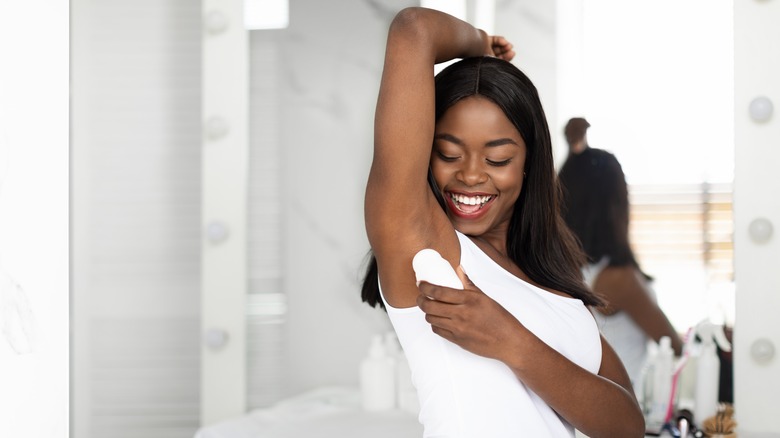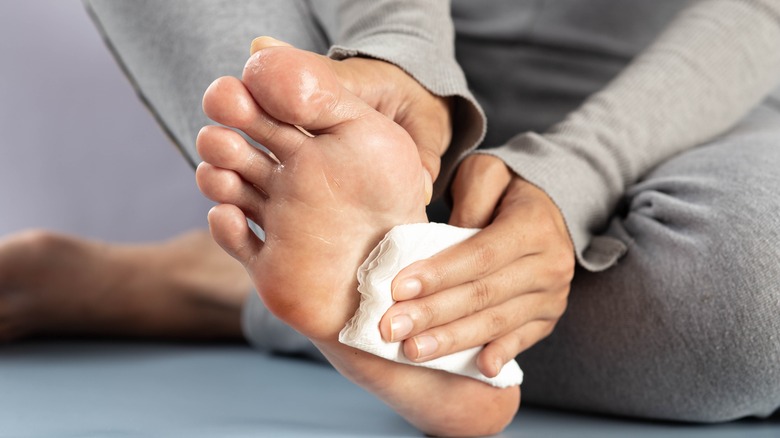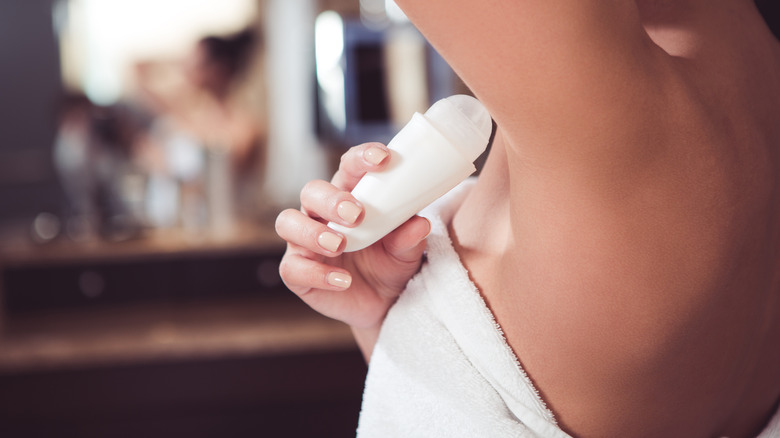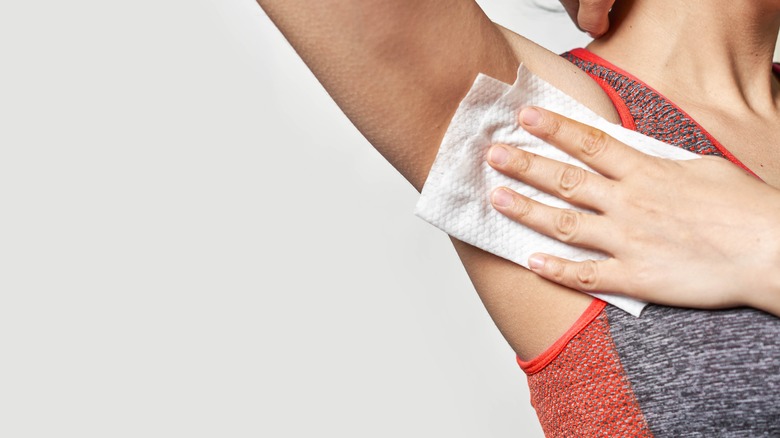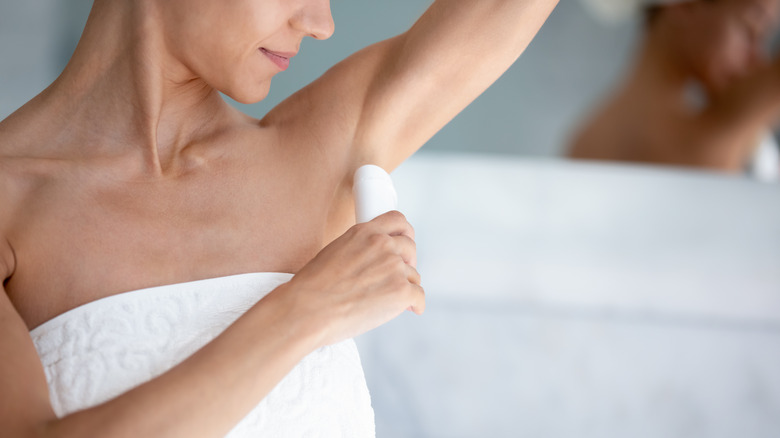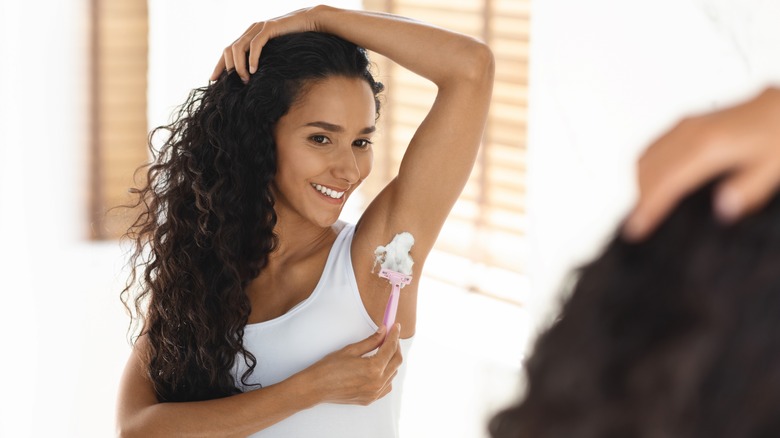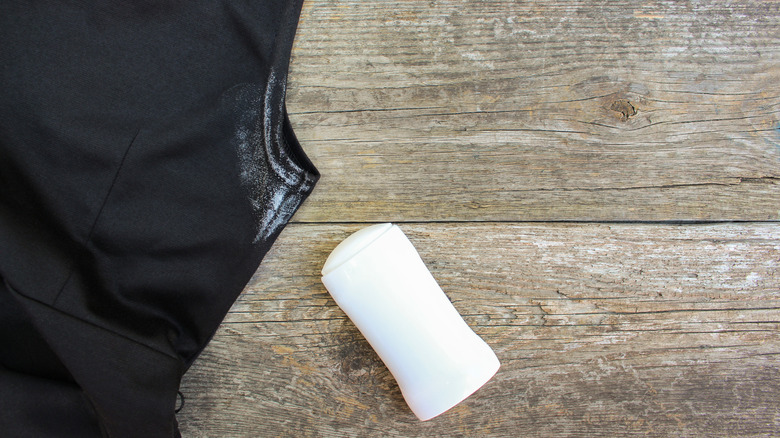Who Knew You Could Make So Many Mistakes With Deodorant? Here Are 8 To Avoid
For most people, deodorant is their first health and beauty product. It's incredibly simple — just grab a product that seems to work for you and apply it under your arms to keep body odor at bay. Most of us haven't given our deodorant much thought in the years we've been using it, but it turns out there are several things you can do to help increase your deodorant's effectiveness that you may be overlooking.
While many of these mistakes aren't the end of the world — most people get by just fine with a few swipes in the morning — they can make a major difference on a sweaty day. If you find yourself battling body odor at the gym or having to reapply more than once a day, you might be making one of these mistakes. A simple switch or two could mean all the difference in your confidence, comfort, and scent, especially during the warmer months.
Only using it under your arms
As it turns out, antiperspirant is more of a multi-use product than people give credit to. Most users stop their application after using it on their underarms, but several other areas can benefit from a swipe or two. If there are certain areas on your body that seem to sweat more when the heat rises, adding a thin layer of antiperspirant deodorant can help prevent this. Popular locations include the backs of the knees and under the chest, but it can also help prevent chafing between the thighs during shorts season.
If you suffer from sweaty feet, you can also use an antiperspirant deodorant to help block sweat glands, though the application method is slightly different. Applying a thick swipe of deodorant and immediately putting on shoes can get uncomfortable, so it's recommended that you devote a layer to dry feet before bed and wash them off in the morning. The sweat-preventing effects should last throughout the day, leaving you dry and comfortable, even during the summer months.
Applying too much
Many people think the more deodorant you apply, the better it will work, but the opposite is true. All you need is two or three up-and-down swipes to get the full effect — any more, and you're just wasting product and causing it to ball up as you wear it throughout the day. The same application rules apply to gel and rollerball deodorants, while two to three seconds per arm a few inches away is usually enough for spray deodorants.
Antiperspirant works by blocking the pores that produce sweat, so adding more layers than what's needed on the surface of the skin isn't going to provide any extra protection. The same is true for a deodorant that doesn't include an antiperspirant. These products are essentially just used to kill bacteria and reduce smell because sweat is odorless, so a thin coat is enough to do the job daily.
Applying deodorant after sweating
If you've recently hit the gym or been outside in hot weather, you might be tempted to add an extra layer of deodorant to help counteract any sweat or body odor. While this won't cause any harm besides the possibility of some annoying residue under your arms, it's not a very effective time to apply. Antiperspirant needs to get into your pores to block the release of sweat, and it's much more difficult for it to absorb into the skin if you're already sweating.
The best time to apply antiperspirant deodorant is much sooner than needed. If you plan to hit the gym in the morning, apply a layer of deodorant at night while your body temperature is at its lowest. Using your deodorant before bed will give it the ability to sink in properly and the time it needs to get to work, meaning that by the time you head to your 8 a.m. fitness class, you'll be fully protected.
Not cleansing between reapplications
If you still feel like you need extra freshness after your workout, it's best to fully wipe down your underarms before applying an additional coat of deodorant. This won't be as all-encompassing as a shower, but if you're quickly transitioning from the gym to brunch, a simple scrub with a wet wipe or washcloth can help kill any odor-causing bacteria and give you a blank slate to reapply your deodorant.
After you wipe down, ensure you give your underarms a few seconds to dry, then go in with a few swipes of your product. Adding additional layers of deodorant might help mask the smell temporarily because of the fragrance it leaves behind. Still, the only way to ensure your product reaches its full effectiveness is by cleansing beforehand. If you frequently want to reapply while out and about, consider keeping a pack of wet wipes and a travel-size deodorant in your purse or gym bag to save you in a pinch.
Not choosing a complementary scent
Deodorant is often a bit of an afterthought when applying your fragrance for the day, but choosing a scent in the same family as your go-to perfume can help elevate the product and create the impression that it's longer lasting. A lot of the time, we don't realize just how many scented products go into our daily routine. Things like hair products, lotions, and laundry detergents all blend to create a unique cocktail of fragrances, so if you want to maximize their impact, try to streamline your choices by scent pairing.
If you're a gourmand or floral scents fan, this is pretty simple. Many women's deodorants have notes of vanilla or powdery florals to act as an easily complementary base to a more complex perfume. For lovers of woody, aquatic, or musky scents, you might have to take a look at the men's aisle. It can be harder to pin down the exact notes when most have names like Swagger or Wolf Thorn, but most are a woody base note with some botanicals layered on top.
Not knowing the difference between antiperspirant and deodorant
The words "antiperspirant" and "deodorant" are often used interchangeably, so deciding what you need can be confusing if you're looking for a new product. Antiperspirants usually contain aluminum and prevent your body from releasing sweat after application. Deodorant, on the other hand, doesn't do anything to lower your sweat levels — instead, it's used to prevent any smells that happen when sweat and bacteria interact. It kills the bacteria under your arms, leaving just odorless sweat behind.
Most products you'll see on store shelves contain both deodorant and antiperspirant ingredients, but the growing push to stick to more natural, clean ingredients has caused a boom in aluminum-free products that only act as a deodorant. If you've ever picked up a natural deodorant and wondered why it hadn't done much to temper sweat, it's probably because it doesn't contain an antiperspirant. These products can be just as effective when preventing body odor, but if you want something to keep you dry, look out for the label to ensure you're grabbing an antiperspirant deodorant.
Putting it on right after you shave
Many people are quick to put on their deodorant right after they shower, but if you shave your underarms, you might want to give it a bit of extra time. Shaving, especially coarse hair, can cause some mild irritation and nicks in the area. Additionally, shaving acts as a form of exfoliation, clearing away dead skin on the surface. Combine these factors, and you're often left with an area that feels raw right after you step out of the shower.
Because of this, applying deodorant immediately after shaving could leave you with an unpleasant burning sensation, especially if you use a formula with a lot of fragrance. To avoid this, wait until you're fully dry and your skin returns to its normal state. The best way to do this is by showering at night, allowing yourself to dry off thoroughly, and then changing into your pajamas. After this, your body temperature and any irritation should return to normal, allowing you to apply your deodorant to get the most effective and comfortable results.
Not using a simple trick to get it off clothes
If you're a devotee of the all-black look, deodorant stains could be your worst enemy. Even if your deodorant is supposedly dry, it seems like at least a small amount rubs off on your favorite dress or T-shirt, especially on tight clothing. The easiest way to avoid this is applying after you've already changed into your outfit and leaving your arms up in the air for a minute or two to let everything dry out, but let's be honest — who has time for all of that?
Inevitably, you'll end up with a few deodorant stains and marks on your clothes over time, but there's a simple solution to help remove them in a pinch without doing extra laundry. Simply grab a pair of nylon tights and rub the area, and the stain will come right off. If you're more of a casual dresser, the rough texture of denim will also do the trick and brush away excess product without damaging the fabric.
